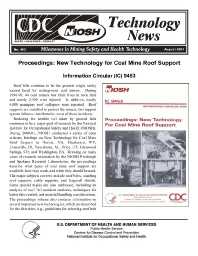Mining Publication: Technology News 493 - Proceedings: New Technology for Coal Mine Roof Support
Original creation date: August 2001
Roof falls continue to be the greatest single safety hazard faced by underground coal miners. During 1996-99, 44 coal miners lost their lives in rock falls and nearly 2,400 were injured. In addition, nearly 6,000 noninjury roof collapses were reported. Roof supports are installed to protect the miners, but support system failures contributed to most of these incidents. Reducing the terrible toll taken by ground falls continues to be a major goal of research by the National Institute for Occupational Safety and Health (NIOSH). During 2000-01, NIOSH conducted a series of open industry briefings on New Technology for Coal Mine Roof Support in Norton, VA, Charleston, WV, Evansville, IN, Tuscaloosa, AL, Price, UT, Glenwood Springs, CO, and Washington, PA. Drawing on many years of research undertaken by the NIOSH Pittsburgh and Spokane Research Laboratories, the proceedings describe what types of coal mine roof support are available, how they work, and when they should be used. The major subjects covered include roof bolts, standing roof supports, cable supports, and longwall shields. Some special topics are also addressed, including an analysis of roof fall accident statistics, techniques for better skin control, and material handling considerations. The proceedings volume also contains information on several important new technologies, which are described for the first time, e.g., guidelines for selecting roof bolt length, pattern, and capacity that were derived from statistical analysis of the roof fall experience at 37 underground mines; a new design method for longwall tailgate supports; and a technique for measuring loads developed within cable bolts. The titles of the papers in the proceedings are: 1. Roof and Rib Fall Incidents and Statistics: A Recent Profile; 2. Fundamentals of Coal Mine Roof Support; 3. Trends in Roof Bolt Application; 4. Assessing Coal Mine Roof Stability Through Roof Fall Analysis; 5. Load Behavior of Grouted Bolts in Sedimentary Rock; 6. Summary of Field Measurements of Roof Bolt Performance; 7. Skin Failure of Roof and Rib and Support Techniques in Underground Coal Mines; 8. Design of Roof Bolt Systems; 9. Design Methodology for Standing Secondary Roof Support Systems; 10. Optimizing Secondary Roof Support with the NIOSH Support Technology Optimization Program (STOP); 11. Cable Support in Longwall Gate Roads; 12. Material Handling Considerations for Secondary Roof Support Systems; 13. NIOSH Safety Performance Testing Protocols for Standing Roof Supports and Longwall Shields; 14. Examining Longwall Shield Failures From an Engineering Design and Operational Perspective; 15. Factors To Consider When Purchasing a New Set of Longwall Shields; 16. Instruments for Monitoring Stability of Under ground Openings; and, 17. Evaluation of Ground Support at a Trona Mine Using Instrumented Cable and Rebar Bolts.
Authors: National Institute for Occupational Safety and Health
Technology News - August 2001
NIOSHTIC2 Number: 20022800
U.S. Department of Health and Human Services, Public Health Service, Centers for Disease Control and Prevention, National Institute for Occupational Safety and Health, Technology News 493, 2001 Aug :1-2
See Also
- Calibration and Verification of Longwall Stress Models
- Critical Review of Numerical Stress Analysis Tools for Deep Coal Longwall Panels Under Strong Strata
- Detecting and Managing Dynamic Failure of Near-Seam Features in Coal and Nonmetal Mines
- Multiple-Seam Mining in the United States: Design Based on Case Histories
- Numerical Modeling Procedures for Practical Coal Mine Design
- Proceedings: New Technology for Ground Control in Retreat Mining
- Protective Structures for Low-Coal Shuttle Car Operator
- The State-of-the-Art in Coal Pillar Design
- Technology News 526 - Proceedings of the International Workshop on Rock Mass Classification in Underground Mining
- Using the Coal Mine Roof Rating (CMRR) to Assess Roof Stability in U.S. Coal Mines
- Content source: National Institute for Occupational Safety and Health, Mining Program


 ShareCompartir
ShareCompartir
